An Illustrated History of Old Sutton in St Helens, Lancashire
Part 41 (of 95 parts) - Sutton Tragedy Part 1
Tragedy Of A Pond | The Luck Of The Irish? | Death Under Chloroform
The Ironic Tale of the Roby Family's Fortune Teller and the Ditton Train Crash
Also See: Sutton Tragedy Part 2 | Sutton Tragedy Part 3 | Crime Part 1
Researched and Written by Stephen Wainwright ©MMXX Contact Me
Old Sutton in St Helens
The Dad's Army Tragedy
Heroic Sutton Nurses
The Tragedy of a Pond
The Luck of the Irish?
Death Under Chloroform
Ironic Tale of Fortune Teller
The Tragic Drowning of Two Boys
The death of a child is always a distressing event but Sutton witnessed a particularly traumatic Christmas during 1899 when two children perished in the icy waters of the Monastery Dam reservoir off Gerard's Lane, with one youngster heroically attempting to save the life of the other. It was a particularly cold December and the reservoir, owned by the London and Manchester Plate Glass Company and supplying Sutton Glassworks, had frozen over. So a number of Sutton children took the opportunity to have some fun by sliding and skating on the ice as kids do. Amongst them was 10-year-old George Thomas who lived at 24 Waterdale Crescent in Sutton and 14-year-old William Roberts who lived close by at 11 New Street. George was sliding near a culvert when the ice, which was thin in places, suddenly fractured throwing him into the water.William was skating at the other end of the reservoir but saw what was happening to young George and so immediately sped to his aid. However as he attempted a heroic rescue, more ice collapsed and he too sank into the freezing reservoir. Unperturbed, he continued trying to save George by pushing him back onto the ice. However, his courageous effort in the reservoir's icy waters was too much for him and both lads sank underneath the ice. Their cries brought local farmer John Whalley from Gerrards Lane to the scene, who used a ladder to extricate the boys from the water. Attempts at resuscitation through artificial respiration were undertaken by a number of Sutton bobbies including Sergeant Jackson aided by the parish nurse. This lasted a remarkable 90 minutes but proved to be in vain and Dr. Bates, who had a practice in Junction Lane, pronounced both boys dead.
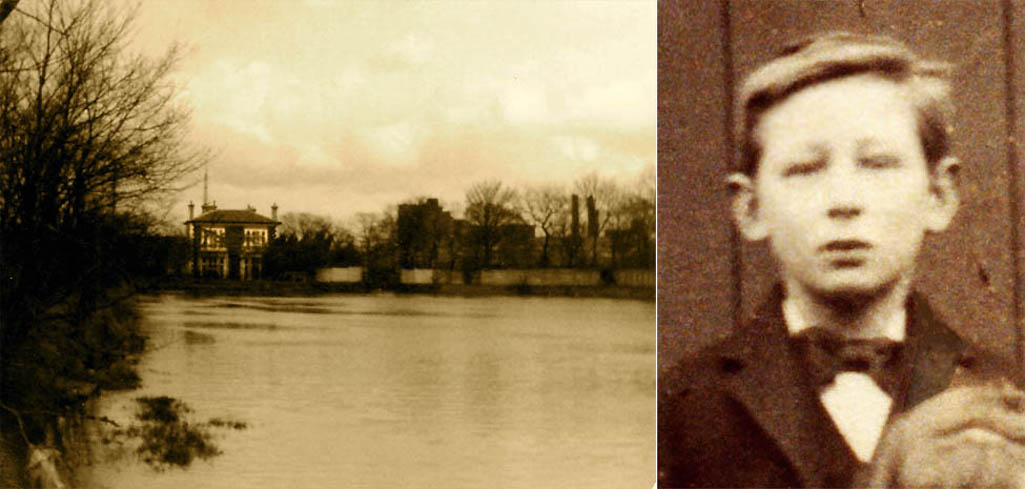
Left: Monastery Dam with convent - contributed by Ian Campbell; Right: William Roberts - contributed by Frank Jones

Left: Monastery Dam with Sutton Convent; Right: Photo of William Roberts

Monastery Dam and William Roberts
Sutton's popular G.P. Dr. Henry Baker Bates became Mayor of St.Helens for four successive terms during the Great War years and his second wife, Alice Ann Rigby, was also related to the Roberts family. Finally, if the name Whalley sounds familiar, the farming family - whose farmland spread from Gerards Lane to New Street - lent their name to the old dam and orchard by the reservoir.
Other skating deaths in Sutton include 21-years-old George Woodward of 43 Ditch Hillock who on January 15th 1876 also drowned when skating on the glass works' frozen reservoir. The ice suddenly gave way and it took half an hour before he could be extracted. Then on Saturday, February 22nd 1895, three young Cannington Shaw workers named Marr, Hilton and Savage slid on the ice covering a dam owned by Sudden Lodge Chemical Works. The ice gave way and the trio fell into the water. Savage climbed out and engine driver John Smith saved Hilton by fastening a rope round his own waist and dragging the lad out. However, 14-years-old Thomas Marr couldn't be rescued and drowned.
'Dad's Army' Tragedy
During WWII, locals who were too old to join the forces or were in reserved occupations joined the Home Guard to defend St.Helens against the threat of invasion. Sherdley Park's 'C' Company, based at Sherdley Hall, were a substantial unit of over 60 men who were led by Captain Hamilton. Like their fictional equivalents in television's Dad's Army, Home Guard units regularly went out on weekend manoeuvres and Lord Derby allowed them the use of his land in nearby Knowsley.
Sherdley Park 'C' Company based at Sherdley Hall led by Captain Hamilton photographed in 1942

Sherdley Park 'C' Company led by Captain Hamilton pictured in 1942

Sherdley Park 'C' Company in 1942
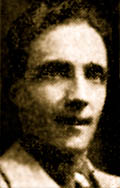
Lieutenant Allan Jones who led the party dived in first and it was stated at the inquest that all were strong swimmers and weren't made to swim the dam. Joseph Lea, father of James, was also present and he told the inquest that the officers and men did everything they could to save his boy, who was due to have married Kathleen Corcoran of Elton Head Road later in the year. Jimmy's funeral was a very sad affair and he was interned at St.Helens cemetery with full military honours. As for Joseph Evans, he was a married man, having tied the knot with Elizabeth Smith née Johnson in 1938.
The Heroic Sutton Nurses
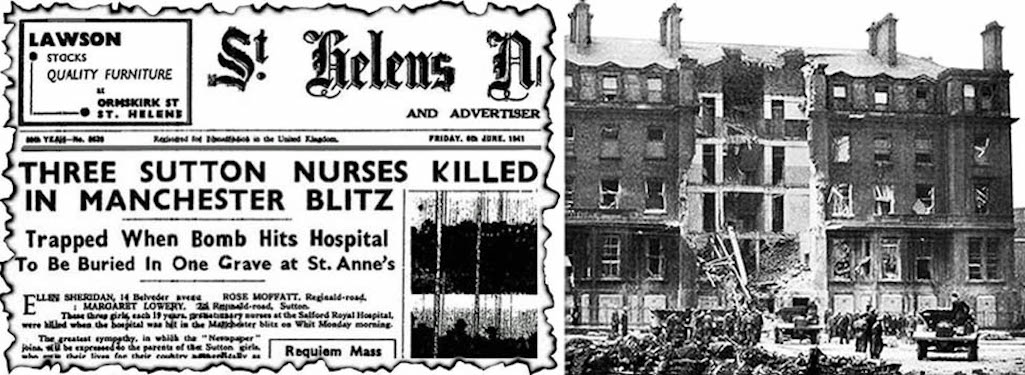
Left: St.Helens Newspaper report on the death of the three Sutton nurses; Right: Salford Royal hospital after the bomb hit

St.Helens Newspaper report and Salford Royal hospital after the bomb hit

St.Helens Newspaper report and Salford Royal Hospital after the bomb hit
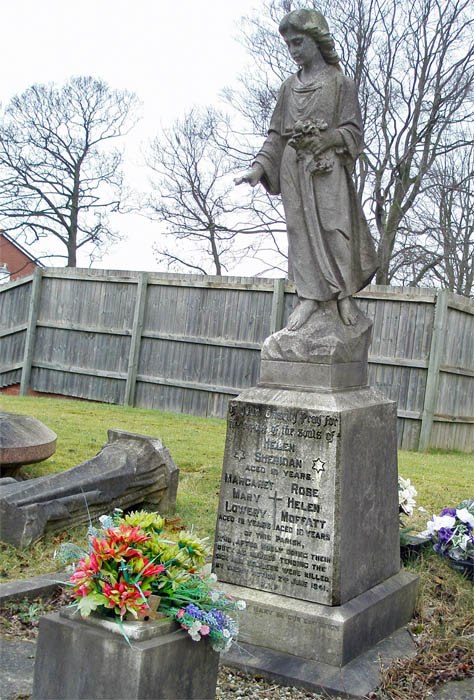
Rose and Margaret both lived with their parents in Reginald Road while 'Nellie' Sheridan lived nearby in Belvedere Avenue, Sutton Leach. Margaret and Ellen were born and bred Sutton girls whilst Rose came from Aldershot. When her parents decided to move to St.Helens, she joined Ellen and Margaret at St.Annes RC School. They soon became best friends and the threesome attended St.Annes Church and played a prominent part with the church's youth mission, the Children of Mary. After leaving school Rose and Margaret joined Littlewoods in Liverpool whilst Ellen became a clerk. However, early in 1940 Rose and Margaret decided that nursing was their true vocation and they took up probationary positions at Salford Royal Hospital and Ellen was easily persuaded to join them.
On Saturday May 31st 1941 Ellen Sheridan was back at home in Sutton enjoying a weekend off. An hour after returning to the hospital late on the Sunday night, an air raid siren sounded and the second-heaviest attack on Manchester during the Second World War was about to begin. The three Sutton girls were amongst a group of nurses who evacuated 150 patients from the Salford Royal to a nearby building. Just after midnight on Whit Monday a sustained ninety minute blitz saw high explosive and incendiary bombs dropped on Manchester, Salford and Stretford.
One bomb tore its way through the building where the evacuated patients and staff where sheltering and was deflected into the roadway. Its explosion caused part of the building to collapse, trapping the nurses. On Monday afternoon the parents of Rose, Margaret and Ellen back in Sutton were informed that their children were missing. Twenty workers clawed at the debris for two days until late on Tuesday evening, the bodies of 14 nurses were recovered.
On February 16th 1944, a monument to the nurses was unveiled at the hospital by the Duchess of Kent. At one time Salford Royal in Chapel Street was the largest hospital in Manchester, although the impressive building has recently been converted into luxury apartments. The monument has been replaced by a memorial plaque to the fourteen women who lost their lives.
However, the Sutton girls are remembered by an imposing memorial in the graveyard of St.Anne's & Blessed Dominic church in Monastery Lane, close to the entrance gates. They were very well known in Sutton and their deaths was a great shock to the community whose feelings were summed up by the St.Helens Newspaper of June 10th 1941 in their front page story:

Memorial to the nurses at St.Anne's
Tragedy of a Pond
Until recent times one of the most dangerous things a woman could do was bear children, often considered her main role in life. An astonishingly high number of females died during the act of giving birth or soon afterwards. New-born babies had a tough time too, with very high infant mortality rates. If they survived their birth and many didn’t, getting through their first year of life could not be taken for granted. Sutton’s own GP, Dr. Baker Bates, lost three of his own children during the 1890s aged 1 day, 7 months and 10 months. If the local doctor couldn’t save his own kids, what hope was there for ordinary Sutton folk?There was little support for new mothers and little understanding of post-natal depression, as we now know it, apart from a recognition that childbirth could cause 'temporary insanity'. This ignorance could have tragic consequences as in the case of Sutton Manor's Rachel Makin.
Benjamin Makin had served in the Boer War and was a hewer at Sutton Manor colliery, charged with cutting out the coal. He lived with his wife Rachel at 23 Milton Street and on the 7th July 1916, she gave birth to a son that they named Eric. Thirty-six year-old Rachel subsequently became weak and depressed and complained of severe pains in her head but it wasn't thought important enough to call a doctor. Neighbours were instead asked to keep an eye on her while her husband was at work and on August 8th after returning home from the pit, Benjamin was told that his wife had been somewhat strange all day.
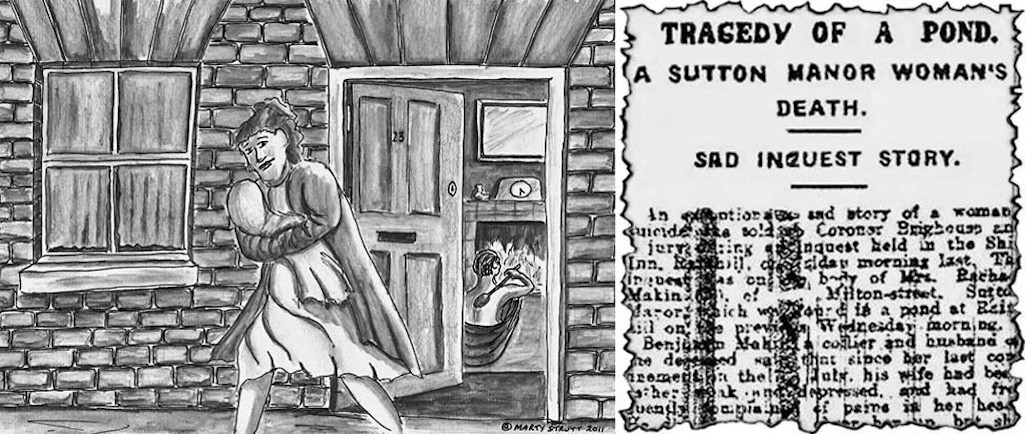
Left: Marty Strutt depicts Rachel Makin leaving home with her baby; Right: St.Helens Reporter 18/8/1916

Marty Strutt depicts Rachel Makin leaving home with her baby

Rachel leaves home with her baby and a St.Helens Reporter account
Rachel was a Sunday School teacher who was said to have regularly prayed and sung hymns. As a deeply religious person, taking her own life would have normally been anathema to her. However, since the birth of her son, she’d clearly not been her normal self. The jury at Rachel’s inquest which was held at Rainhill’s Ship Inn, returned a verdict of ‘suicide whilst temporarily insane’. These days matters have improved somewhat and post-natal depression, which affects up to 15% of women, is much better understood. However, it wasn't until the 1961 Suicide Act that taking one's own life was decriminalised. Being buried in unconsecrated ground at night (daylight burial was permitted from 1882) along with estate forfeiture were the penalties for the deceased and their families. For many of those who survived their suicide attempt, they had an unpleasant fortnight in the harsh Whiston workhouse to look forward to, possibly in its 'imbecile' ward.
The 'Luck' of the Irish?
As Sutton became more industrialised and with improved train infrastructure, so labour was attracted from all parts of the country and even abroad. The Welsh came to the Copper Works in number and there were even a few highly skilled glassmakers from France employed at Sutton Glass Works. The French glassblowers were said to be big lads who liked to scrap in their spare time! Suttoners became used to small numbers of 'outsiders' working and living within their midst and there seems to be little evidence of problems with integration. Irish immigrants were, however, a different matter.By the 1840s, the Irish famine led to the trickle of migrants to Britain that had begun in the '20s, turning into a torrent. A quarter of a million a year left the Emerald Isle, with the vast majority arriving in Liverpool. They were described a 'half naked and starving' with many making the journey as deck cargo on cattle steamers. Huddled together they endured a terrible crossing, occupying minute spaces between the cattle pens. The Irish migrants were exposed to storms and rough seas and arrived awash with animal filth and sometimes frozen to the deck.
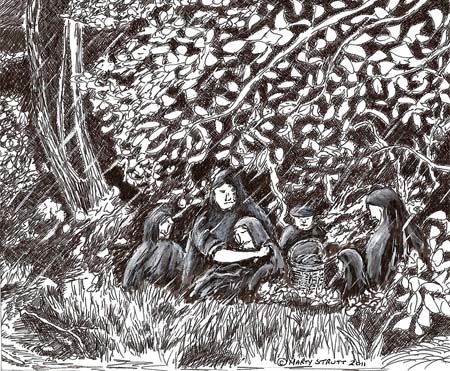
As early as 1836 there'd been an Irish murder in Sutton. Patrick Daveny (or Davenay) and Thomas Murray had been employed on James Welsby's farm potato digging when Joseph Monks attacked them. The killing took place on October 18th, just two weeks after they'd arrived in England from Roscommon in Ireland. The pair had walked across Marshalls Cross railway bridge to buy bread from a local shop and seen three men with sticks watching them. Upon their return, they decided not to cross the bridge but then heard some children shout "Paddy, Paddy make haste or you will get a thrashing". Although Murray outran the chasing men, Daveny was repeatedly struck by railway labourer Monks using a horn-tipped stick. The young man's skull was broken and one newspaper claimed that the attacker had shouted "I'll have no Irishmen coming over to this country".
Tensions were further raised two years later when the Protestants of St.Helens celebrated The Battle of The Boyne with a provocative march that led to some fighting and damage of Irish property. Some Irish passed through Sutton and Bold on their way to other parts of the country. Exhausted by their dreadful crossing of the Irish Sea and with no money for lodgings, the migrants found shelter where they could. Bridget Gallaghan was a 40-years-old widow who arrived in Liverpool in April 1850 with her four children and cousin Rose. They planned to walk to Bridget's sister in Yorkshire and after staying at Knotty Ash the first night, reached Bold the following afternoon.
A local woman, Mrs. Nelson, allowed the travellers to make porridge and gave them some hot coffee but presumably didn't want them in her house overnight. Instead they spent the night in the pouring rain under a hedge and remained there until 5am. Hearing the cries of Bridget's children, a woman in a neighbouring house belatedly came to help. Bridget was carried to a straw stack but died within minutes.
The four children were placed in the workhouse and may well have ended up eventually with their auntie in Yorkshire. Many thousands of other Irish trudged inland throughout England and endured similar privations until they were able to find somewhere to settle. It was a tough life being Irish in England with considerable prejudice being experienced, but it was thought better than being 'back home' starving. No one seems to know the precise derivation of the term 'luck of the Irish' but it's unlikely to have come out of those terrible famine years both at home and abroad.
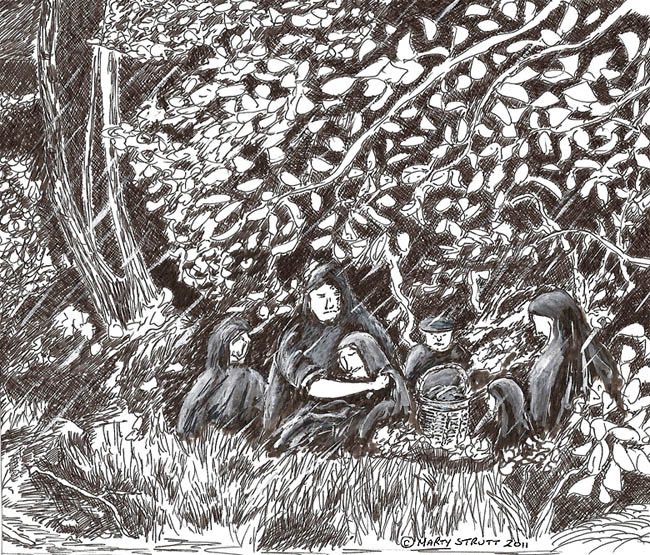
Marty Strutt depicts Bridget Gallaghan and family spending the night at Bold

Marty Strutt depicts Bridget at Bold
Death Under Chloroform
In the years before the National Health Service, the payment of doctors' fees was a problem for both patients and medics. The poor could little afford the cost of medical care and some of the better-off would do what they could to evade payment. There were also many disputes over who was liable for footing the doctor's bill, especially in the case of industrial accidents. Consequently, medical conditions would not always be properly treated and Sutton's doctors ended up in court attempting to get paid.On March 9th, 1887 Dr. Edward Casey sued Andrew Jackson, manager of the Collins Green Colliery Company, in St.Helens County Court for £14 12s. This was the Junction Lane medic's fee for treating four pit-sinkers who had been seriously injured in an explosion at Bold Colliery the previous May. When Jackson sent for the doctor, his only thought was in getting speedy treatment for the men, not for who was liable for paying for his services. As pit work was generally contracted out, there was a dispute between the company, contractor and manager over who had responsibility for coughing up. However, as Andrew Jackson was the one who'd summoned the doctor in the first instance, he was the one who received a legal summons from Casey. Although the judge found in favour of the plaintiff, he was clearly uncomfortable with his own verdict and it's easy to see how many Sutton folk would be reluctant to call out a doctor for someone else if they ended up being personally liable, like Jackson did. As for Dr. Casey, he didn't care who paid him his fee, as long as somebody did!
Ten years later, on April 23rd 1897, Mrs. Almond of Webb Street, Sutton appeared at St.Helens Police Court charged with exposing her child, who had scarlet fever, in public. In her defence Mrs. Almond claimed that Dr. Casey had never told her that her child had contracted the infectious disease. She wanted to call the Irish medic as a witness but he said he wouldn't attend court unless he was paid "the usual fee". Although his attitude might seem callous, he did have a living to make and which wasn't always easy. On July 1st 1896, Sutton's Dr. Henry Baker-Bates sued William Dixon of Earlestown for £9 19s for treating his sick wife. The couple were living apart at the time of the treatment and Dixon had placed adverts in a number of local papers stating that he would not be responsible for any debts contracted by his wife. She subsequently died and so Dixon refused to pay Bates's bills. He claimed that the doctor's visits had nothing to do with him and the judge agreed and found in favour of the defendant.
By this time, Baker-Bates had his own practice in Junction Lane, but just a few years earlier as an unqualified assistant to Dr. Thomas Pennington, his future father-in-law, he'd learnt how confusion over medical bills could lead to tragedy. During the summer of 1890, 60-year-old Ellen Borrows of Gerards Lane was treated by Dr. Pennington for a growth on a finger and she became an in-patient at the Peasley Cross Cottage Hospital. On August 13th, 24-year-old Baker-Bates informed Ellen's husband, John, a labourer at Sutton Glassworks, that her finger would have to be amputated and a specialist would have to be brought in at a cost of two guineas to administer chloroform to his wife.
Borrows believed that the operation wouldn't take place until he raised the cash, whereas Dr. Pennington simply needed his consent to operate. The matron of the Peasley Cross hospital, Annie Stocks, made preparations for the procedure to take place the following day, but neither Dr. Pennington nor his assistant Baker-Bates showed up, having not received the required consent. So that night a desperate John Borrows implored Dr. Casey to help his wife and he travelled to the hospital without talking to Pennington. Both Sutton's doctors, 41-year-old Casey and 47-year-old Pennington, had surgeries in Junction Lane at nos. 1 and 10 respectively, but didn't get on at all well with each other.
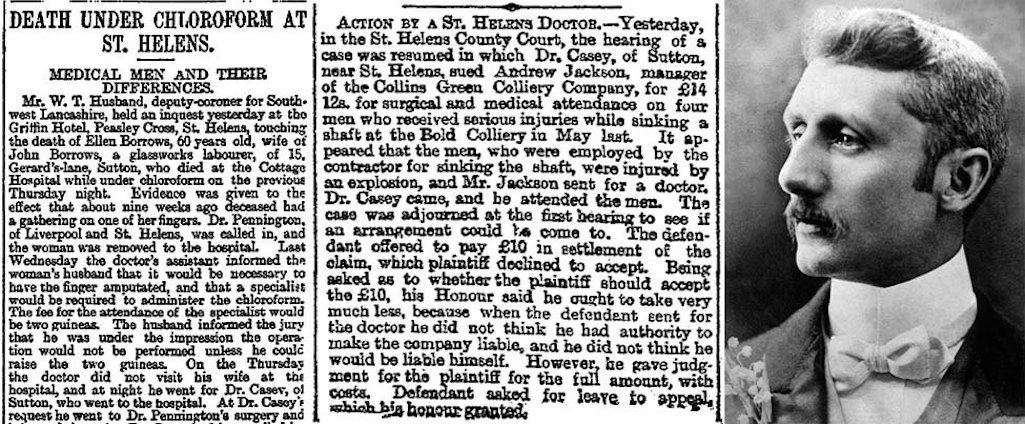
Liverpool Mercury reports dated August 19th 1890 (left) and March 10th 1887 (centre); Right: Dr. Henry Baker Bates

Liverpool Mercury reports from 1890 and 1887 and Dr. Henry Bates

Liverpool Mercury reports and Dr. Bates
Ironic Tale of the Fortune Teller & Ditton Train Crash
The Borrows family of Sutton were major industrialists and devout Roman Catholics who named their locomotives and iron works factory, Providence Foundry, after their faith. It was begun by Edward Borrows (1823 - 1881) in the back garden of his Pecker's Hill Road house in February 1868. He was largely uneducated but was responsible for a number of engineering inventions and was a skilled draughtsman. At his funeral in 1881, sixty of his workmen processed in front of his hearse and the family firm was continued by his five sons after his death.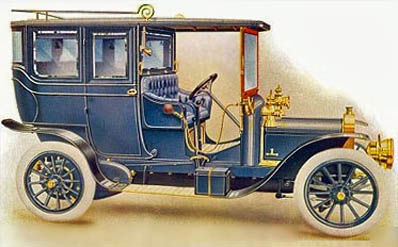
In September 1912, Albert and Agnes drove to Llandudno for a holiday in their 1908 works Sunbeam which was driven by their chauffeur who was called Wainwright. Whilst at the Welsh resort, Agnes visited a clairvoyant to have her fortune told, only to receive the grim news that she was going to endure a terrible accident. Assuming that the prediction meant a car crash, an alarmed Agnes informed her chauffeur that he would be returning to Rainhill on his own, as the couple were now planning to go home by train.
So on September 17th, the Roby's boarded the 5.30pm Chester to Liverpool train, which consisted of nine coaches plus engine. After passing through Runcorn station and across Runcorn Bridge, the train approached a bend at Ditton Junction, near Widnes. Upon occasions when London-bound trains on the same line had become delayed and were behind the Liverpool train, the latter was signalled to move onto a slow line, so the London train could get in front. This had happened eleven times since the beginning of August with the driver having to slow down considerably to 15mph.
However, when it occurred on this occasion, the driver of the 5.32, 41-year-old Robert Hughes, failed to decrease speed and his express rocketed round the bend at 50mph. At 35mph, it would have had a fighting chance of staying on the track, but not at 50. So the engine left the rails and ran for 100 yards before smashing into a bridge, followed by the foremost carriages.
Despite electricity being a much safer option, the train operators were still using gas to illuminate their carriages and so all but the rear coaches were soon ablaze. Fifteen people lost their lives including the Robys and thirty-nine passengers were injured. Albert was burnt beyond recognition and could only be identified by his pocket watch and his collar which had Roby on it. His wife Agnes was decapitated and the medical report said her skull was 'completely smashed to atoms' and her brains were missing.
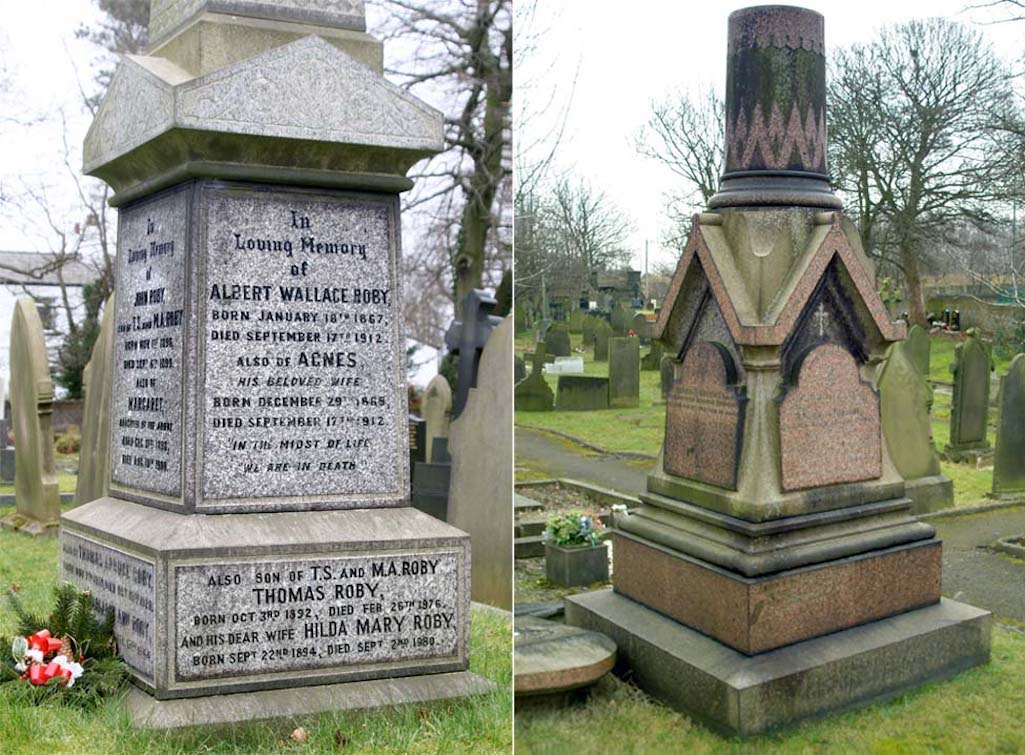
Left - Roby memorial in Rainhill Churchyard; Right - Borrows memorial in St.Anne's Churchyard

Roby memorial in Rainhill Churchyard and Borrows memorial at St.Anne's

Roby memorial in Rainhill Churchyard and Borrows memorial at St.Anne's

A Standard Sunbeam 1908 limousine



